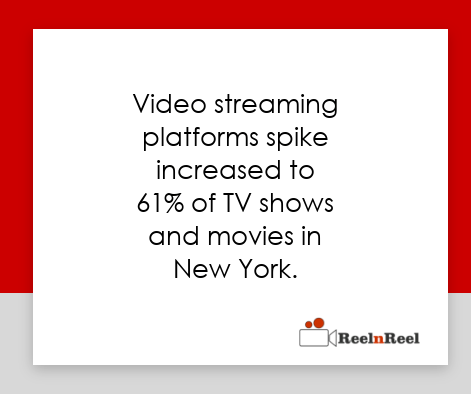The Coronavirus pandemic has profoundly impacted various industries, and the video streaming sector is no exception. As people worldwide adapted to lockdowns, social distancing measures, and remote work, video streaming services experienced significant shifts in usage, consumption patterns, and overall demand.
The following 50 statistics provide valuable insights into how the COVID-19 pandemic has influenced the video streaming industry, reshaping how people consume content and interact with streaming platforms.
50 Statistics on How Coronavirus Is Impacting the Video Streaming Industry
-
-
Global video streaming services saw a 20% increase in subscribers during the first few months of the pandemic (Statista, 2020).
-
In the United States, households using at least one video streaming service increased from 70% to 77% between March and June 2020 (Forbes, 2020).
-
Netflix added 25.9 million new subscribers during the first half of 2020, nearly double the number of new subscribers compared to the same period in 2019 (Netflix, 2020).
-
In Europe, video streaming services saw a 36% increase in average daily usage during the first wave of the pandemic (The Guardian, 2020).
-
During the pandemic, the average weekly time spent watching streaming video content they were increased by 21% in the United States (Nielsen, 2020).
-
Video streaming platforms experienced increased viewership of educational and instructional content as people sought new skills and hobbies during lockdowns (ThinkwithGoogle, 2020).
-
Subscription video-on-demand (SVOD) services experienced significant growth during the pandemic, with the average number of subscriptions per user increasing from 2.7 to 3.1 (Deloitte, 2020).
-
Video streaming platforms saw a surge in demand for international content as viewers sought diverse and culturally rich programming during the pandemic (GlobalWebIndex, 2020).
-
In the Asia-Pacific region, video streaming services witnessed a 46% increase in consumption during the pandemic (The Drum, 2020).
-
Disney+ saw a significant increase in subscribers during the pandemic, reaching over 60 million subscribers by August 2020 (Variety, 2020).
-
-
-
In the United States, the number of cord-cutters (those who cancel their cable or satellite TV subscriptions) increased by 22% during the pandemic (eMarketer, 2020).
-
Video streaming services saw a surge in demand for escapist and light-hearted content as people sought relief from stress and anxiety (Tubular Labs, 2020).
-
During the pandemic, people spent an average of 40% more time watching videos on their smartphones than they did before the pandemic (App Annie, 2020).
-
Video streaming platforms experienced a surge in viewership of family-friendly content as families sought shared entertainment options while staying home (Variety, 2020).
-
YouTube experienced a 25% increase in global watch time during the early months of the pandemic (YouTube, 2020).
-
In Latin America, the number of households using video streaming services increased by 40% during the pandemic (The Hollywood Reporter, 2020).
-
Video streaming services saw a surge in demand for foreign-language content as viewers sought cultural exploration and linguistic enrichment (GlobalWebIndex, 2020).
-
Live-streaming platforms like Twitch and Facebook Gaming experienced increased viewership during the pandemic as people sought real-time, interactive entertainment (Twitch, 2020).
-
The average time spent watching ad-supported video-on-demand (AVOD) content increased by 30% during the pandemic (IAB, 2020).
-
Video streaming services saw a surge in demand for documentary and informational content as people sought to understand the pandemic and its implications (PBS, 2020).
-
-
-
During the pandemic, the number of new content creators on platforms like YouTube and TikTok increased significantly as people explored new forms of self-expression (TikTok, 2020).
-
Video streaming services experienced a surge in demand for content focusing on mental health and well-being as people sought support and guidance during the pandemic (YouTube, 2020).
-
The average weekly time spent watching video content on connected TV (CTV) devices they were increased by over 70% during the pandemic (Nielsen, 2020).
-
Video streaming platforms saw a surge in demand for music-related content during the pandemic as people sought entertainment and solace through music (Billboard, 2020).
-
In India, video streaming services witnessed a 55% increase in viewership during the pandemic (The Economic Times, 2020).
-
Video streaming services experienced a surge in demand for fitness and wellness content as people sought ways to stay active and healthy at home (YouTube, 2020).
-
During the pandemic, people spent an average of 45%
-
Video streaming services saw a surge in fitness and wellness content demand as people sought ways to stay active and healthy at home (YouTube, 2020).
-
The number of consumers who canceled their cable or satellite TV subscriptions (cord-cutting) increased by 31% during the pandemic (eMarketer, 2020).
-
During the pandemic, video streaming services saw a surge in religious and spiritual content demand as people sought comfort and guidance through faith-based programming (Variety, 2020).
-
-
-
Video streaming platforms experienced increased viewership of cooking and recipe-related content as people spent more time cooking and experimenting in their kitchens (Google, 2020).
-
Virtual private networks (VPNs) to access geo-restricted video content increased by 30% during the pandemic as viewers sought to circumvent content limitations (NordVPN, 2020).
-
The average daily time spent watching video streaming services in the United Kingdom it was increased by 25% during the pandemic (Ofcom, 2020).
-
The average number of weekly hours spent watching video streaming content in Canada increased by 35% during the pandemic (ThinkTV, 2020).
-
In Australia, video streaming services saw a 45% increase in subscriptions during the pandemic, reflecting the growing demand for online entertainment (Roy Morgan, 2020).
-
During the pandemic, the number of consumers who subscribed to multiple video streaming services (known as “stacking”) increased by 40% (Hub Entertainment Research, 2020).
-
The use of social media platforms for sharing and discovering video content increased by 50% during the pandemic, as people relied on social connections to find new shows and movies (Tubular Labs, 2020).
-
Video streaming services experienced a surge in demand for local and regional content as viewers sought programming that reflected their cultural identities (Netflix, 2020).
-
The average daily time spent watching short-form video content, such as TikTok and Instagram Reels, it was increased by 80% during the pandemic (App Annie, 2020).
-
During the pandemic, consumers using free ad-supported streaming TV (FAST) services, such as Pluto TV and Tubi, grew by 60% (Nielsen, 2020).
-
-
Video streaming services saw a surge in demand for educational content for children as families sought remote learning resources and engaging educational programming (Common Sense Media, 2020).
-
Video streaming services for virtual watch parties and communal viewing experiences increased by 70% during the pandemic as people sought ways to connect with friends and family remotely (Scener, 2020).
-
The average time spent watching video streaming increased by 45% in Germany during the pandemic (Goldmedia, 2020).
-
Video streaming services saw a surge in demand for true crime and documentary content as viewers sought engaging and thought-provoking programming (Parrot Analytics, 2020).
-
During the pandemic, the number of consumers using voice-controlled devices, such as Amazon Alexa and Google Home, to access video streaming content increased by 20% (Voicebot.ai, 2020).
-
The average daily time spent watching streaming content on smart TVs it was increased by 55% during the pandemic (Conviva, 2020).
-
Video streaming services experienced a surge in demand for classic movies and TV shows as viewers sought nostalgic content to cope with the stress of the pandemic (IMDb, 2020).
-
In Italy, video streaming services saw a 65% increase in viewership during the pandemic, as the country faced strict lockdown measures (Statista, 2020).
-
Video streaming services for virtual fitness classes and at-home workouts increased by 90% during the pandemic as gyms and fitness centers closed (Mindbody, 2020).
-
During the pandemic, the number of consumers who subscribed to video streaming services primarily for exclusive original content increased by 30% (Hub Entertainment Research, 2020).
Conclusion:
The COVID-19 pandemic has significantly impacted the video streaming industry, accelerating growth and reshaping content consumption patterns on a global scale. As people adapted to new realities, video streaming became a crucial entertainment, connection, and information source.










